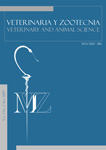Authors
Abstract
ABSTRACT: Introduction: The routine methods used for lipid profile measurement in humans, a species with LDL pattern, needs to be evaluated for its use in the lipid profile determination for species with HDL pattern. Objective: The objective of the present study was to compare the direct method and the precipitation method for the measurement of HDL cholesterol in species with HDL pattern. Materials and Methods: Samples of 200 horses of different ages without discrimination by sex or age that were fasting were obtained. After serum extraction, levels of HDL cholesterol were determined using the direct and the precipitation methods. The results were statistically analyzed using one way ANOVA. Results: The direct method reported values in mg/dl for media, minimal, maximal, range, and standard deviation of 62.2; 37; 101; 64; 10.7 respectively. The precipitation method reported values for media, minimal, maximal, range, and standard deviation of 62,14; 40; 101; 61; 2,8 respectively. The P value in test F is greater or equal to 0.05, reason why there is no statistical significant evidence at a confidence level of 95% between values obtained using both methods. Conclusion: It is recommended to use any of the two analyzed methods for HDL-cholesterol measurement in species with HDL pattern.
Keywords
References
Álvarez, M.E.; Suárez-Vela, Y.J.; Cañas-Vélez, E.S. Comparación entre el método directo y el método de precipitación para la determinación de los niveles de colesterol LDL en equinos. Revista Colombiana de Ciencias Pecuarias, v.22 (3), p.402, 2009.
Barter, P.J.; Brewer, H.B. Jr.; Chapman, M.J. et al. Cholesteryl ester transfer protein: a novel target for raising HDL and inhibiting atherosclerosis. Arteriosclerosis Thrombosis and Vascular Biology, v.23, p.160-167, 2003.
Bauer, J.E. Metabolismo comparado de lípidos y lipoproteínas. Pet´s Ciencia, v.13, p.362–376, 1997.
Brewer, H.B. Jr.; Santamarina-Fojo, S. Clinical significance of high-density lipoproteins and the development of atherosclerosis: focus on the role of the adenosine triphosphate-binding cassette protein A1 transporter. American Journal of Cardiology, v.92, p. 10K-16K, 2003.
Coppo, N.B.; Coppo, J.A.; Lazarte, M.A. Intervalos de confianza para colesterol ligado a lipoproteínas de alta y baja densidad en suero de bovinos, equinos, porcinos y caninos. Revista de Veterinaria, v.14, p.1-10, 2003.
García, A.; Barbaras, R.; Collet, X. et al. High density lipoprotein 3 receptor-dependent endocytosis pathway in a human hepatoma cell line (HepG2). Biochemistry, v.35, p.13064-13071, 1996.
Goldberg, D.I.; Beltz, W.F.; Pittman, R.C. Evaluation of pathways for the cellular uptake of high density lipoprotein cholesterol esters in rabbits. Journal of Clinical Investigation, v.87, p.331- 346, 1991.
Tietz, N.W. Clinical guide to laboratory tests, 2nd edition. Saunders Co, New York, USA, 1991.
National Cholesterol Education Program Expert Panel. Third report of the National Cholesterol Education Program (NCEP) Expert Panel on Detection, Evaluation, and Treatment of High Blood Cholesterol in Adults (ATP III). NIH Publication. Bethesda: National Heart, Lung, and Blood Institute, 2001.
Peelman, F.; Vandekerckhove, J.; Rosseneu, M. Structure and function of lecithin cholesterol acyltransferase: new insights from structural predictions and animal models. Current Opinion in Lipidology, v.11, p. 155-160, 2000.
Pittman, R.C.; Steinberg, D. Sites and mechanisms of uptake and degradation of high density and low density lipoproteins. Journal of Lipid Research, v.25, p.1577-1585, 1984.
Rader, D.J.; Regulation of reverse cholesterol transport and clinical implications. American Journal of Cardiology, v.92, p.42J-49J, 2003.
Tall, A.R.; Jiang, X.; Luo, Y. et al. Lipid transfer proteins, HDL metabolism, and atherogenesis. Arteriosclerosis Thrombosis and Vascular Biology, v.20, p.1185-8, 2000.

 PDF (Español)
PDF (Español)
 FLIP
FLIP










